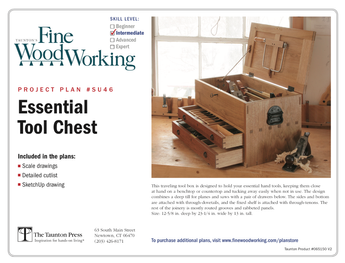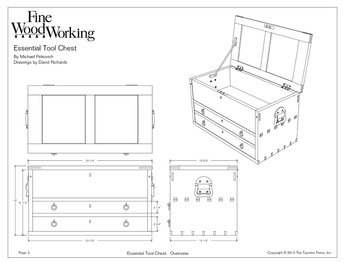I would like to know if anyone has had experience with using a hollow chisel mortiser in hardwoods? I have tried this multiple times with limited success, and on more than one occasion ruined my chisel due to heat buildup. When installing the chisel and bit I use the recommended dime to create the required space between the end of the bit and chisel. It still is a struggle to get the chisel to bore through the wood. I am typically using red or white oak when trying to mortise. If anyone has any tips/tricks regarding this topic I would greatly appreciate it.
Thank you!














Replies
Bolt or clamp the mortiser to the bench. (Assuming benchtop unit) Make sure the hold down is snug. I'll put wedges under the forks sometimes.
Sharpen the chisel and make sure the outside is smooth. There are cone-shaped sharpening stones for the inside surfaces... use a diamond stone for the outside.
Extend the drill bit a touch further than that dime. There will be less support for the side fibers to resist the chisel.
Pull hard. It takes more force than I was comfortable with at first. Ignore the horrible noise. Use your body weight.
Make sure to clear the interior of the chisel between cuts. They can get packed up.
I have a Delta and a Jet. I prefer the Jet because it spins at half the speed of the Delta... less noise and less smoke.
I use my Powermatic benchtop model regularly with great results. If you are using the "dime" to create the needed clearance between the chisel and bit, I would turn your attention to tuning up those important cutting components.
On the chisel, carefully sharpening of four sides to a mirror polish, and a careful sharpening of the interior (with the appropriate cone) makes a big difference, including cleaning up the interior (as best you can) with wet/dry sandpaper to make ejecting chips smooth and easy.
On the bit, sharpen the cutting edges with an auger bit file to create good cutting edges, and then smooth the bit exterior with wet/dry sandpaper, and the area immediately above the auger to make them as smooth as possible.
Put it all back together and before starting, give the hollow chisel a squirt of Bostik Glidecote or some other dry lubricant, not too much just a quick squirt, turn the machine on and let the propellant evaporate. And then re-apply every two or three mortises, or when things start to get a bit noisy again.
These details really made a different for my machine, hopefully for you too.
Agreed on the sharpening advice. Very essential here.
I have moved away from chisel mortisers but I don't have a great one (Chinese). I'm using plunge routers now with templates and generally more happy. I see some of those old US cast iron ones weighing a ton; maybe one of those would be better. For bigger mortises (think timber framing), I'm using a chain mortiser and love that tool.
I agree with everything MJ said and really like where jac took it. Cleaning up the bits and sharpening/polishing is a must. I’ll add that I’ve had much better success with a 3/8” bit over a 1/2” bit. I have the powermatic bench top machine.
I’ll attach a pic here of a current commission I am using it on. 78 mortises. Took about an hour including set up with the machine. Don’t get discouraged if it doesn’t look as clean as you’d like, there are other elements at play like tenon shoulders that hide some slop.
Bench/cover thing
If I remember correctly, Bob Van Dyke has an excellent tutorial in this website prepping a bit.
Thanks to everyone for the great advice. I was able to obtain some sharpening cones for the inside edges and polished the outside of the chisels to a mirror finish. For this attempt I used a 1/2” and a 1/4” with great success. The 1/2” required a little more muscle but at no time did it feel excessive. I really appreciate the help. Thanks again everyone!
Glad to hear it worked out.
I visited a friend's parents in the countryside in England in 2022. His Dad was a retired Joiner (that's British for Woodworker). He had a vintage hollow chisel mortiser in his shop down below which he was using at the time to build new farm gates around his property. This was a huge stationary, floor-based machine with a lever arm at about 4 ft long. It was a grand old beast. The material was oak. He showed me how to use the machine with the instruction when cutting the mortise: you need to nibble away at it a bit a time. These nibbles were about 1/4 to 3/8 inch at a time, raising the bit to clear it after each cut. I could have finished the job for him - so fun. For me, this was the same way as boring a hole in wood on the drill press. I would never expect to do a full-depth plunge cut in any wood, especially hard English oak.
Here is a photo of the Hollow Chisel Mortiser which I referred to in my previous post.
Interesting machine - looks intended for big mortises.
I'll make one more comment on this topic, and that is the technique I use with mine to cut mortises. After having cut hundreds, I have found that I get the cleanest mortise by starting at one end of the marked mortise cutting a hole, then moving the board a mortise-and-a-half or so left or right cutting the next square hole, then on down the line until I get to the other end. Then I go back the other way to clean up the remaining "ribs" to finish the entire width. It's an extra pass, but this gives me the cleanest result.
Why? Good question. My theory is that any time you make a cut with pressure on three sides of the chisel, it flexes a bit - which generates some extra heat and can make the sidewall a little wonky. Probably doesn't matter if you working with poplar, but white oak or other beefy hardwoods is another matter. So every pass is made cutting four sides or two sides; this puts even pressure on the chisel.
Probably overkill, but try it, I'd be curious to hear other's results.
I noticed a long time ago that if I just started at one end and proceeded, the end wall from the last cut was not vertical. I had seen the same chisel deflection where it made a difference. So now I do both ends before removing the middle. I just do most of a full cut instead of leaving a bridge between initial holes. I may try to figure out if there is more heat the way I'm currently doing it.
I love the carriage and vise system on that old cast iron beast. I have found that keeping that damn wood exactly in the same spot, pass after pass, is hard to do without something like this. All that steel and cast iron = lots of strength, weight and little deflection. Plus all that leverage.
I have a delta benchtop gathering dust... anyone going to FWNE that wants to make an offer hit me through the inquiries form on the website in my profile.
I got rid of mine too. Too much slop in the mechanism made it flex while engaging.
I don’t use mine that much either. Don’t think I would purchase it again. I keep hoping someday I do a project that needs lots of mortises so I can feel like it was worth owning.
Never had an issue with it. I just had a chance to buy a Jet super cheap and I like the slower spindle speed better.
Sharp cures so many ills with these machines. Diamond cones for the insides and stones of some sort for the outside. These cutters need to be sharper than your beard razor and touched up as required.
I may have missed it in all the discussion of sharp chisels and drill bits, but you'll also want to polish the inside of the chisel, above the sharpened part. This is a Bob Van Dyke tip. He wraps a slotted dowel with emery paper. Works great, then I did the same with a metal rod only because small pieces of wood tend to disappear in my shop. Apologies if this is a duplicate.
Yes, you want to polish as much of the inside of the mortise chisel where the chips are drilled into and cleared. The more that is polished, the easier and faster the chips can get out of the system. This makes performance much better. If those chips are slow to clear, they can build up, slowing performance and even catch on fire with all the heat. Good chisels from Japan or the like come with pretty good insides, but bad chisels from China and the like can be very rough and as such, very difficult to use.